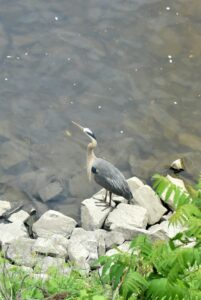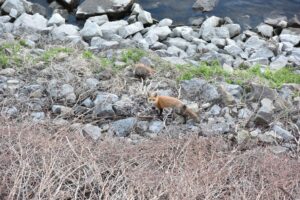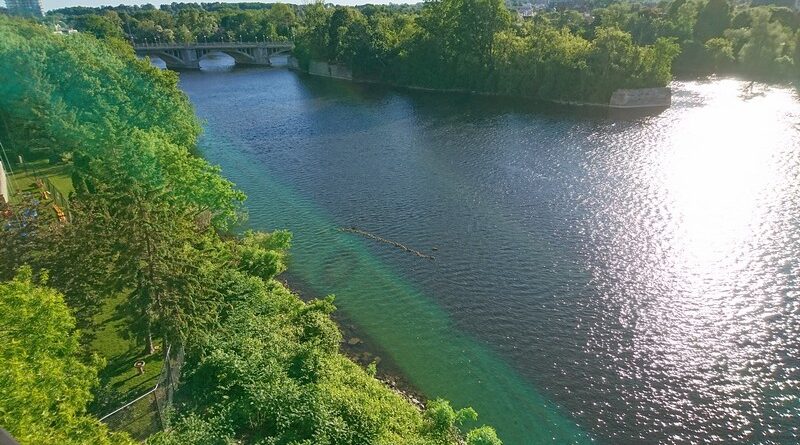Duck Duck Goose: A year of Rideau River living
Jean Rath
I have lived beside the Rideau River between Cummings Bridge and the Adàwe Crossing for six years. Here is one year’s representation of the creatures that share the space with me.
Cold open water
Early in January, the only ice on the river is along the shoreline, and on a grey winter’s day a large flock of diving ducks show up in front of our building, their white chests a bright contrast to the grey water. We think they’re buffleheads. There must be over 50 of them spread up and down the river, and they keep disappearing under the water and re-appearing in turns.
Across the river, four mallards sit on the shoreline ice and watch. Nothing is going to entice them to dive underwater!
The flock of buffleheads returns day after day, even when ice floes form and travel down the river. These floes are twice the size of the ducks, but they shrug them off, merrily skirting them or diving underneath. On bright days, we can see their outlines zipping around under the water.
The colder it gets, the more the shoreline ice extends into the river. One day, a furry thing appears on the ice shelf across the river. It’s so big and furry, I wonder if it’s a small bear. The binoculars reveal it to be a beaver! Another smaller one shows up a little later. They spend a long time there, sometimes diving into the water and then returning to the ice.
One day, a large turkey decides that our part of the river is a place of interest. It starts peering into the windows of the ground-level apartments in our building. His appearance creates quite a buzz on the building’s WhatsApp group!
Party on the river

By February, the river is frozen solid. After a snowfall, the river is criss-crossed with cross-country ski and snowshoe trails but also little prints, telling of nighttime critter shenanigans. The only animals we see by daylight are the black squirrels that like to run back and forth from our shore to Cummings Island in the river. But if we’re at the right window at the right time of the night, we can still catch sight of creatures.
One night, two foxes appear on the ice. They bark at each other, approach each other and then run away. We think it’s a fox mating game. After all, spring and pups are only a couple of months away.
Late the following evening, a ball of fur appears on the ice over by Cummings Island. We think it’s the fox again, but in the dark, we can’t really tell. The creature starts crossing the ice, and the closer it gets, the less like a fox it becomes. It waddles, for one thing. When the ball of fur is close enough to come into profile, we see it is a raccoon.
But then we do see the fox! It is sitting on the ice in the middle of the river, watching the progress of the raccoon with great interest. It finally gets onto its belly and creeps along the ice to intercept the raccoon’s trajectory. Once there, it sits up, at which point the raccoon stops and faces it—it is then clear that the raccoon is the same size as the fox!
They stare each other down for a long time. Finally, the fox runs back to the middle of the river and the raccoon heads up the south side of our building where it lives. I’m very glad the raccoon got home safely. Perhaps I should be just as glad for the fox!
Goose tales

Early in March, the Canada geese begin to arrive. They are unbothered by the fact that the river is still frozen. They merely walk around the middle of the river as if it is ready for them to swim in. As the river thaws, more geese arrive. They must have a lot of stories to tell, because they are very noisy!
A pair manage to secure a slice of riverbank for themselves right below our apartment building. The female creates her nest, and by early April, the nest has seven eggs! The building’s WhatsApp group comes alive at this development!
The goose sits for several weeks, through rain, snow and sleet. It’s not very exciting, but neither is it without drama. The male goose occasionally has his hands full with interlopers. They may not have ill intentions toward the nest, but the goose is not taking any chances. If any creature gets too close, the male assumes his menacing stance: full height with wings spread out. The mink, the crows and fellow geese all get that treatment. If a goose gets too close (“too close” can be as far as halfway across the river), the male chases it down the river, making an alarming ruckus.
One day, a gaggle of visitors arrived— six geese who climb up on shore and started nibbling the thin grasses beside the shore. The nesting couple is uncharacteristically unbothered. I theorize these geese were last year’s hatchlings come to say hello to the folks.
Much to the excitement of the entire building, the eggs hatch one morning in May. We can see the little balls of fluffy yellow cuteness manoeuvring around the nest. One wiggles its way out and seems to have a hard time getting back. I worry for the little gosling, thinking about how skinny it is with the cold night to come. But it does manage to make its way back to the nest. The goslings spend most of the day under their mother, occasionally poking their little heads out to entertain us.
Early the next morning, I arrive at my window just in time to see the goose family swim away and disappear up the river. They never come back. It seems that one day and one night is all these babies need before they are ready to strike out to the green fields of Strathcona Park to get big and strong in time for migration, which is only a few months away.
But one dud egg is left in the nest, and it attracts a lot of attention. A crow flies down, digs around, pokes at the egg and leaves. Then a lone goose walks up to the nest, sits on the egg for a while and leaves. The mink skulks along the shore and is chased off by a crow.
But it is the evening visitor that evokes a reaction from the geese! While the geese are scattered all over the river, the fox shows up and paws at the nest, causing about 15 geese to come charging from all directions and park themselves in the water in front of the nest. When the fox walks down the shore, the gaggle follows as one. When the fox stops, the gaggle stops. As a group, the swimming fowl follow the fox down the shore and don’t let up until it heads back up the riverbank.
And then there is no more dud egg in the nest.
Party on the river, part II

Photo Christopher Rath
According to Internet info, it sometimes happens that geese form a “creche.” By the end of May, a creche of about 50 goslings and their attendant two or three adults establishes a definite presence on the river. I like to think our goslings are part of that crew. The creche dominates the river, but that doesn’t stop the other creatures from enjoying its early summer warmth and bounty.
One sunny day in May, the river is a veritable Saturday in the park. A flock of swallows flies all over the river’s bug-ridden surface while three cormorants swim sleekly under the water and then dry their wings on a mid-river rock that they have to share with the turtles (I guess turtle is not on cormorant menu). The gulls are everywhere, and on the shore below our building, the goldfinches, cardinals and redwing blackbirds hang around the shore scrub while the sandpiper and heron poke around the water. As dusk falls, the bats appear, swooping and turning and catching bugs in front of our apartment.
Lazy on the river

When the geese moult and can no longer fly, they bob around on the river, often sticking their white tails straight up out of the water to snap up the nice eating from the shallow bottom. The goslings become gangly teens very quickly—I no longer call the large group of 50 “the creche”; now, they are “the youth group.”
The geese bob, the cormorants sit on the mid-river rock and dry their wings, a snapping turtle and then a large fish swim lazily by, and at night, the tree frogs on Cummings Island peep. It’s the lazy days of summer.
A merganser mom and her tiny ducklings hang out around the shallows near our building. The eight little ones can dive for food just like their mom. The tiny fluffy things disappear suddenly under the water, one by one, and then bop back up in quick succession, looking like a fleet of starships coming out of hyperspace. If any of them get too far from mom, she quacks, and the little one skims across the water like a speedboat to get back to her.
Flight School
By early August, the spring goslings all look like their parents. Now it’s time to teach them to fly. Small gaggles of geese take off (with great cacophony) and fly low over the water. Sometimes they get as high as the trees. Wherever it is they fly to in order to practice, they soon return, practising their group splash downs. They are a treat to watch as all of them together soar downward with their wings in hooked formation, adjusting the wings constantly to catch the right air currents until they all land in quick staggered succession with a soft, elegant swoosh.
“Well done kids,” I say as they land. I say something similar when I’m a passenger on an airplane that is executing just such a landing. I suspect the pilot uses the same technique as the geese.
As the weeks go by, the gaggles fly higher and farther, always returning to the river for a night’s rest. Sometimes they don’t return until after dark. I can hear them approaching with their constant honking, and sometimes I can spot the dark, moving line above the dark trees across the river. Then they disappear against the trees. But soon, I can see silhouettes reflected on the still water as they fly over, especially on a moonlit night, and then see the disturbance on the water and hear the swoosh when they land.
As soon as they return, the night, previously given over to rippling water and tree frog peeping, is once again covered in cacophony.
Peace on the river

Photo Christopher Rath
Flight school continues into September, and after awhile, it’s hard to tell if the geese that splash down on the river every evening are the summer residents returning from a day’s practice or gaggles from the north migrating through. I suspect the latter. At one point, there are 200 geese on the river. They rest on the water and feed, white bottoms up, off the underwater reeds. Our river is apparently a popular passing-through point.
As the fall unfolds, there are days at a time with no geese in sight until, by some time in December when everything is grey and white again, they are gone for good. As if they are relieved to finally be rid of their large, noisy neighbours, the diving ducks return with their black and white presence on the grey water lined by grey and white trees.
Then winter sets in. It’s time to start a year on the Rideau River all over again.

